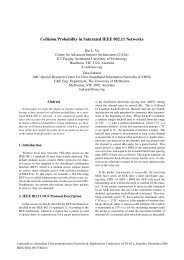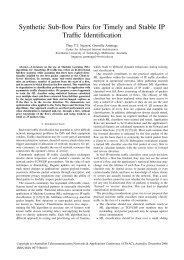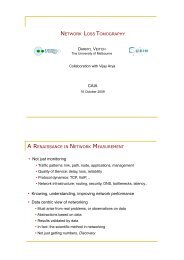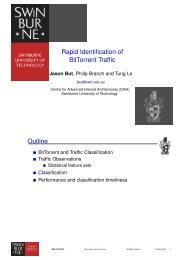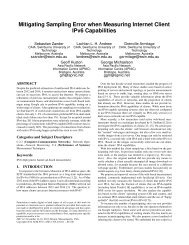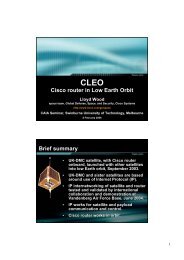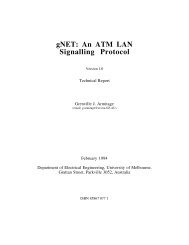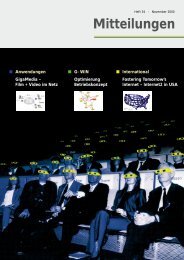Chapter 3 Time-to-live Covert Channels - CAIA
Chapter 3 Time-to-live Covert Channels - CAIA
Chapter 3 Time-to-live Covert Channels - CAIA
Create successful ePaper yourself
Turn your PDF publications into a flip-book with our unique Google optimized e-Paper software.
Error rate<br />
1e−02<br />
1e−04<br />
1e−06<br />
1e−08<br />
MED0<br />
MED<br />
AMI<br />
DED<br />
MEI0<br />
MEI<br />
1 2 3 4 5 6 7<br />
Amplitude A<br />
DEI<br />
DUB<br />
CHAPTER 3. TIME-TO-LIVE COVERT CHANNELS<br />
Error rate<br />
1e−02<br />
5e−03<br />
1e−03<br />
5e−04<br />
1e−04<br />
5e−05<br />
1e−05<br />
MED0<br />
MED<br />
AMI<br />
DED<br />
MEI0<br />
MEI<br />
1 2 3 4 5 6 7<br />
Amplitude A<br />
Figure 3.12: Error rate for different modulation schemes and amplitudes for the <strong>CAIA</strong> trace<br />
(left) and the Leipzig trace (right) (y-axis is logarithmic)<br />
3.5.2 Error rate<br />
Figure 3.12 shows the error rate for the <strong>CAIA</strong> and Leipzig datasets depending on the<br />
different modulation schemes and A (results for other traces are in Appendix B.3). Overall<br />
the error rates for A ≤ 2 are similar <strong>to</strong> the average rate of TTL changes (see Section 3.1).<br />
A notable exception is DUB for the <strong>CAIA</strong> trace. Since this trace contains a large number<br />
of very long flows the probability for TTL wrap-arounds is much higher than for the other<br />
traces. The error rate for MEI and DUB actually increases for increasing A because the<br />
probability of wrap-arounds increases.<br />
MEI0 and MED0 have higher error rates than MEI and MED. This is because often<br />
the probability that the first special zero bit is wrong is higher than the average error<br />
rate, since TTL changes occur more frequently at the start of flows (see Section 3.1).<br />
Both direct schemes and mapped schemes perform equally well for A = 1 as predicted<br />
by the error probabilities (see Appendix B.2). In general the error rate does not decrease<br />
proportionally with increasing A because the empirical error distributions have long tails<br />
as shown in Section 3.1.5.<br />
Figure 3.13 compares the performance of the different modulation schemes averaged<br />
across all traces. For A = 1 the error rate varies between 0.1% and 1%, and MED performs<br />
best, followed by MEI, AMI and the direct schemes. For larger amplitudes MED and AMI<br />
outperform all other schemes. MEI and MED clearly outperform MEI0 and MED0.<br />
We investigated if the error rate for mapped and differential schemes can be reduced<br />
by using hop count differences instead of TTL differences. The receiver converts all TTL<br />
values <strong>to</strong> hop counts. This eliminates errors when the TTL was changed by middleboxes<br />
but the hop count is the same (see Section 3.1.3). For example, the TTLs 56 and 120 are<br />
different but the hop count is 8 in both cases assuming the usual initial TTL values. Our<br />
60<br />
DEI<br />
DUB



